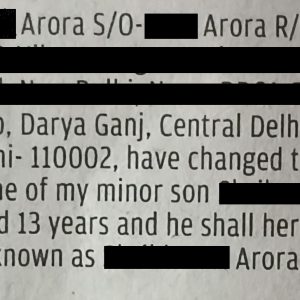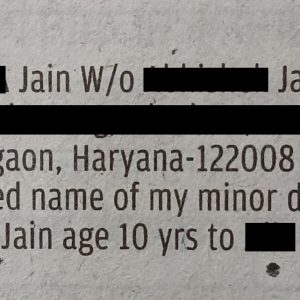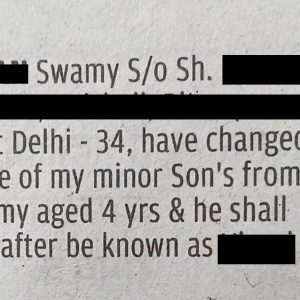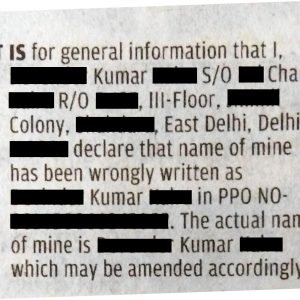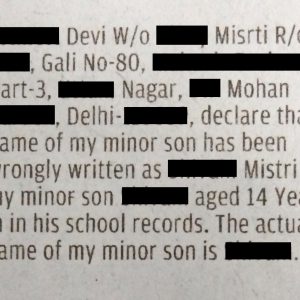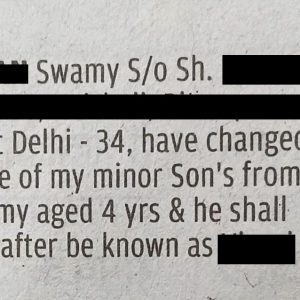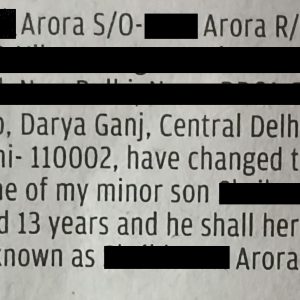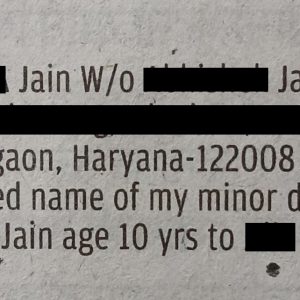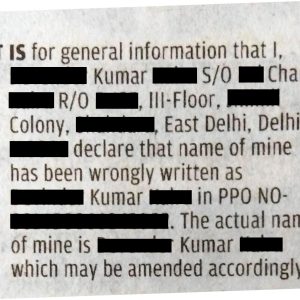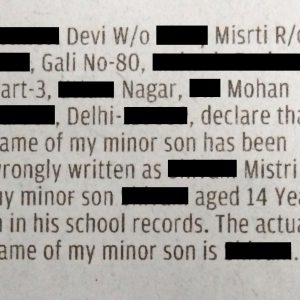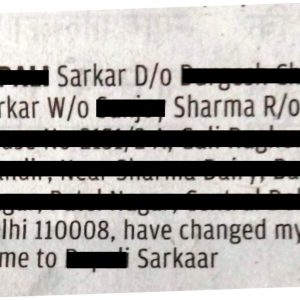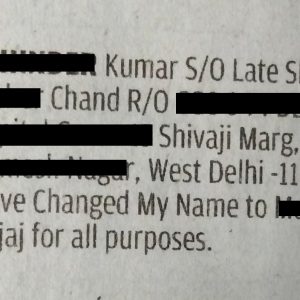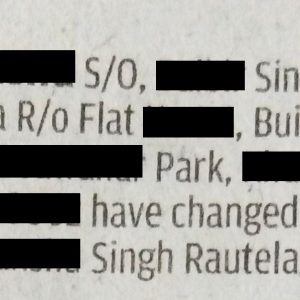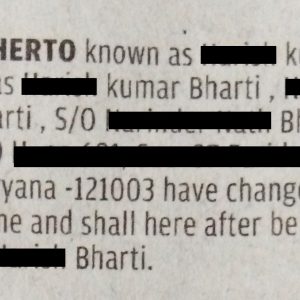Gazette Notification
Name Change & Correction
Required Documents : Aadhar Card, Pan Card, Passport, Voter ID, Education Documents, Birth Certificate (Mandatory Doc - Aadhar Card plus any one)
Name Change - ALIAS
Required Documents : Aadhar Card, Pan Card, Passport, Voter ID, Education Documents, Birth Certificate (Mandatory Doc - Aadhar Card, ID Having Alias plus any one)
Name Change - After Marriage
Required Documents : Adhar Card, Pan Card, Marriage Certificate, Passport, Voter ID, Education Documents, Birth Certificate (Mandatory Doc- Aadhar Card and Marriage Certificate plus any one)
Name Change - After Divorce
Required Documents : Aadhar Card, Pan CArd, Divorce Decree, Passport, Voter ID, Education Documents, Birth Certificate, Re-Marriage Certificate
Correction in Various Docuements
Required Documents : Aadhar Card, Pan Card, Passport, Voter ID, Education Documents, Birth Certificate (Mandatory Doc - Aadhar Card plus any one and doucments having incorrect details))
Minor Son/ Daughter Name Change
Required Documents : Aadhar Card, Pan Card, Passport, Voter ID, Education Documents, Birth Certificate (Mandatory Doc - Either Parents - Aadhar Card plus any one documents and Kids - Aadhar Card, Birth Certificate, School Report Card)
Name and Religion Change
Required Documents : Aadhar Card, Pan Card, Passport, Voter ID, Education Documents Birth Certificate(Mandatory Doc - Adhar Card plus any one and Religion Conversion Certificate)
Name & Gender Change
Required Documents : Aadhar Card, Pan Card, Passport, Voter ID, Education Documents, Birth Certificate(Mandatory Doc - Aadhar Card plus any one and Documents from Hospital for Gender Change)
Explore Publications Regarding Name Change
How to Change Your Name Legally in India: An In-depth Overview
Why Is A Name Important For Your Identity?
A name is more than just a word; it holds significant importance in human life. It serves as an identifier for those who know you, helping them remember you. A name can reflect your family background, culture, or even certain traits of your character. This is why many people carefully consider the idea of changing their names, as it involves meaningful deliberation.
In India, Why Do People Change Their Names?
People in India change their names for a variety of reasons. For example, some people alter it because they were married or divorced, while others do so for religious and personal beliefs like numerology and astrology. Additionally, there are certain cases where people alter their names after switching to a different religion or in an attempt to start over.
Here’s What You’ll Discover In This Complete Guide!
Whether you have just married, divorced, or simply want to change your name for any other reason, this information will be of use to you. It provides a detailed step-by-step instruction on how to get things done, from gathering necessary documents to understanding the legalities involved, so that you may make this life-changing decision with complete confidence.
Why Do People Change Their Names?
Changing a name is a big decision for many reasons. Here are common reasons why people in India change their names frequently:
- Marriage: Changing one’s name is a common part of marriage for many people. Traditionally, many women have chosen to take their husband’s surname, but these days, more men are also choosing to take their wives’ names. Additionally, some couples decide on hyphenated names to reflect both of their identities.
- Divorce: After a divorce, many women return to their maiden names. This makes individuals feel like they’re beginning over and disconnecting from their former experiences.
- Religious conversion: Some people alter their names after converting to a new religion. They adopt a name that reflects their new views and makes them feel more connected to their faith.
- Personal preference: Sometimes people alter their names just because they wish to. Perhaps they dislike their previous name and prefer one that more accurately reflects who they are. There could be numerous personal reasons for this.
- Astrological or Numerological Reasons: In India, some people change their names according to astrology or numerology. They believe that certain names bring good luck or prosperity, so they select a new name to boost their fortunes.
People alter their names for a variety of reasons, including marriage or divorce, religious convictions, personal decisions, or even to bring good luck.
What Are The Regulations For Changing Your Name In India?
Changing your name isn’t as straightforward as simply choosing a new one and starting to use it. You must follow a specific legal procedure. In India, the process for changing your name can vary slightly depending on your state, but it generally involves three key steps:
Draft an affidavit – This is a legal document stating your intention to change your name.
Make a public notice – You are required to publish your new name in a newspaper to inform the public of the change.
Publish it in the government gazette – Getting your name change officially recorded in the government gazette makes it legally recognised.
Why Is It Necessary To Follow The Legal Process?
While bypassing these steps might appear simpler, it is not advisable. Complying with the official process ensures that your new name is legally recognized, which is crucial when updating your passport, purchasing property, or getting married.
Though it may take some time, doing it correctly will help you prevent potential issues in the future. In the following sections, we will explain each step in detail to make the process more understandable and straightforward for you.
What Are The Requirements For Changing Your Name?
A few things need to be checked before you can change your name:
- Age Requirement: In India, you have to be at least eighteen years old to change your name. In addition to other procedures, your parents must approve the name change if you are under the age of 18.
- Citizenship in India: You must be an Indian national. If not, you should speak with the embassy or consulate of your nation, as the regulations may differ.
- No Legal Issues: You shouldn’t be facing any criminal charges or ongoing legal proceedings. Changing your name won’t keep you out of trouble with the law.
You can begin the name-changing procedure when you’ve complied with these guidelines; we’ll go into further detail in the next sections.
Required Documents For A Name Change
The following items are required to process the name change:
1) Your ID, both original and copy
You must first have a valid form of identification, such as your passport, voter ID, or Aadhar card. You must also have a photocopy of the original version in addition to this. While the photocopy is frequently provided with your application as a necessity, the original will aid in your self-identification.
2) Photos the size of a passport
A couple of passport-sized pictures are also required. They are needed at several stages of the name-changing process, such as when submitting an affidavit or filing a legal notice (Gazette).
3) Other Significant Documents
Depending on why you changed your name, make sure you have all the paperwork you’ll need on hand. For example, if you are changing your name because of marriage, you might need a marriage certificate. Proof that demonstrates your conversion is required if it’s due to a change in religion.
Having these records on hand will expedite the process and help prevent any snags in the future. We will outline the steps necessary to legally change one’s name in the sections that follow.
Process For Changing Names In India
The legal procedure of changing your name involves several steps. Every move has a purpose and is significant. To make things easier for you, we will highlight each one individually.
Step 1: Making the Affidavit
An affidavit is the first step in the name-change process. It is a formal document that demonstrates your desire to alter the existing name.
Why is an affidavit important?
Your affidavit, which marks the start of the legal action, is the legally recognised formal statement that you make. Courts and other institutions use it as a reference.
How to Write an Affidavit
Writing an affidavit requires meticulous attention to detail. Your present name, the name you wish to adopt, and the justification for your choice should all be included in this specific paper.
Notarization
After it is drafted, the affidavit must be notarised. You can complete this at the notary public’s local offices. They will authenticate the document by confirming your identification and adding their seal.
Step 2: Publication of the Newspaper
Notifying people of your name change by publishing an ad in the newspaper is the next step.
How Come Newspapers Are Used?
Your name change becomes obvious and public when it is published in a newspaper. In this manner, the shift is visible to everyone, and everyone is aware of it.
Picking the Correct Newspapers
Two publications must issue the notice: one in English and one in the native dialect. To increase their respectability, reputable journals should be chosen.
The Format of Advertisements
The advertisement ought to be simple. Your new name, previous name, and the date the affidavit was created should all be mentioned.
Maintaining Documents: Newspaper Clippings
Save copies of the newspaper clippings when they are published. These are required for the Gazette Notification final stage.
Step 3: Notification in the Gazette
Obtaining a Gazette Notification is the final step in the name change procedure.
A Gazette Notification: What Is It?
An official government pronouncement is called a gazette notification. It’s the last phase that gives your name change legal force.
Application Process
You must apply by sending a form to the Department of Publications with the necessary paperwork, such as the newspaper clippings.
Publication Timeline
Typically, the notification is published in the Gazette two to four weeks after it is submitted.
You can navigate the name-changing process with ease if you follow these steps appropriately. Make sure that no step is omitted because every single one is essential. Following a legal name change, we discuss what to do in the following sections.
Cost Of Changing Your Name In India
1) Affidavit Cost
When creating an affidavit for a name change, the first step is to hire a notary and pay a certain fee for the stamp paper. In India, it now costs around Rs. 20 for everyone to obtain this kind of documentation.
2) The price of publishing a newspaper
Publicising your new name in two local publications is required. Depending on the newspapers selected, this cost may vary, but it’s often inexpensive.
3) Publication Fees in the Official Gazette
Getting your name change published in the Official Gazette is the last step. This entails a charge that changes according to the publication category (Extraordinary or General). A handling fee for the associated papers may also be part of the procedure.
Avoid These Common Mistakes.
In India, changing your legal name requires a number of stages, and mistakes are common. Not getting the affidavit notarized, selecting the incorrect newspapers for the announcement, and failing to save copies of the newspaper articles are a few typical mistakes. Make sure you accurately complete all forms and double-check all papers to prevent delays.
Examples Or Case Studies
Example 1: Change of Name in Marriage
Geeta Sharma changed her last name to Thakur after getting married. Within three weeks of finishing the affidavit procedure and publishing the name change in two local newspapers, she was notified in the Gazette.
Example 2: Conversion to Religion
Rohan Gupta became Saad Khan after converting to Islam. He successfully updated all of his legal paperwork, placed a thorough newspaper ad, and finished the affidavit with proof of conversion.
Services For Changing Your Name Digitally
Several websites, including ezyLegal, offer full solutions for changing your name. They give ready-made paperwork for affidavits, administer Gazette Notifications, and facilitate newspaper adverts, making the entire process easier. Online platforms can help save time and reduce errors.
Legal Support
Hiring a lawyer can sometimes pay off, especially when the case concerns youngsters or when one is involved in legal issues. Legal professionals provide specific recommendations, ensure the accurate delivery of documents, and represent you in the event of a disagreement or legal issues.
Implications Of Changing Your Name
A name change can have far-reaching consequences in one’s life. The name change must be recorded in all legal papers provided, including bank records, educational certificates, and other forms of identification. If this is not done, it may cause legal complications in the future, or when your identification needs to be confirmed.
What To Do After Changing Your Name?
Hooray! You’ve modified your identifier! However, there is still some unfinished business. To be legally recognised in all aspects of your life, your new name must appear in many different documents.
Update The Aadhar Card
Updating your Aadhar card is often the first thing people think of. If you want to change your name on the Aadhar Card, you need to go to the nearest Aadhar Enrollment Centre. Bring your Gazette Notification and a photo ID with you.
Updating Your Passport
As someone who frequently journeys across borders, you must renew your passport. To do so, request the reissue of your passport and present all required documents, such as a Gazette Notification, among other things.
Updating Voter Id
The Voter ID serves as both an identification card and an election tool. If you want to change your name, you must fill out Form 8 and submit it to the Electoral Office together with all other required paperwork.
Update Your Pan Card
Updating your PAN Card is necessary for financial activities. To update your name, fill out the ‘Request for New PAN Card’ form and mail it along with the ‘Gazette Notification’.
Driving License Update
Visit the RTO that issued your driver’s license and apply along with any additional paperwork that might be needed to get your name changed. Everyone will use their new names to identify themselves in this way.
Office Address For Name Change In The Central Government
The government gazette office, also known as the Central Gazette office, is located in North Delhi and has the following official address: Department of Publication, Civil Lines, Delhi-110054. Call 8588887480 (for guidance).
This office maintains the official Gazette, which publishes all name change announcements. The process entails sending your application, necessary documentation, and money to this office for approval and publication.
Cover India Name Change Services In Other States Of India
Name Change in West Bengal, Name Change in Tamil Nadu, Name Change in Himachal Pradesh, Name Change in Andhra Pradesh, Name Change in Madhya Pradesh, Name Change in Uttar Pradesh, Name Change in Kerala, Name Change in Chhattisgarh, Name Change in Punjab, Name Change in Telangana, Name Change in Uttarakhand, Name Change in Odisha, Name Change in Jharkhand, Name Change in Haryana, Name Change in Bihar, Name Change in Karnataka, Name Change in Maharashtra, Name Change in Rajasthan, Name Change in Gujarat
Other Name Change Services Cover India Offer
Name Change in Pan Card, Name Change in Aadhar Card, Birth Certificate Name Change, Name Change Affidavit, Passport Name Change, Name Change After Marriage, Name Change of Minor.
The Conclusion
We have explored the entire method of legal name change, from the reasons for changing names to the legal framework controlling name changes. We have also included crucial pre-requisites, documents required, and a step-by-step instruction on how to change your name.
Changing your name is not an easy procedure, but completing the legal process ensures that all aspects of your new identity are acknowledged. As a result, before taking this step, be sure you have all of the necessary information.
I wish you all the best as you embark on this road of self-transformation or begin a new chapter in your life.
Name Change Services By Cover India In Other Indian Cities
Name Change in India: Chennai, Hyderabad, Delhi, Bangalore, Lucknow, Kolkata, Mumbai, Gurgaon, Jaipur, Indore, Pune, Chandigarh, Noida, Ghaziabad, Ahmedabad, Surat, and Vadodara.
Frequently Asked Questions About Name Change In India.
Changing your name is a huge life event, and it is understandable to have questions. Let us address some of the most frequently asked questions to help you navigate this process with confidence.
Q1. Is The Name-Change Process The Same For Minors?
No, the process for minors is slightly different. Parental consent is normally necessary, and the affidavit must be signed by a parent or guardian. The remainder of the process, such as newspaper publishing and Gazette Notification, is comparable.
Q2: How Long Does The Process Take?
The schedule varies, but the complete process typically takes 2-4 weeks, excluding the time required to update all of your legal documents. To avoid delays, start early.
Q3: What Is The Cost Involved?
The cost varies depending on the state and the newspapers you select for publication. The process typically costs between ₹1000 and ₹3000, excluding fees for revising legal documents.
Q4: Do I Need A Witness? Witnesses For The Affidavit?
Yes, you will need at least one witness when having your affidavit notarized. The witness should know you personally and be willing to confirm your identification.
Q5: How Can I Change My Name Officially In India?
To change your name officially in India, you must file an affidavit, publish a newspaper notice, and acquire a Gazette Notification. This method assures that your new name is legally recognized.
Q6: What Is The Procedure For Changing My Name?
To change your name, you must first create a notarized affidavit, then issue a notice in the media and obtain a Gazette Notification from the government.
Q7: May I Change My Name For Personal Reasons?
You can alter your name for personal reasons, such as numerology or astrology, by going through the legal process.
Q8: How To Alter Your Surname After Marriage In India?
To change your surname after marriage, follow the same steps as for a general name change: produce an affidavit, post a newspaper notice, and acquire a Gazette Notification.
Q9: How Long Does It Take To Legally Alter Your Name In India?
The complete process usually takes 2-4 weeks, excluding the time required to update all of your legal documents.
Q10: What Are The Costs Of A Name Change In India?
The cost varies by state and publication, typically ranging from ₹1000 to ₹3000, minus fees for upgrading legal documents.
Q11: How Can I Update My Name On Legal Papers Following A Name Change?
After receiving a Gazette Notification, change your Aadhar card, passport, voter ID, PAN card, and driver’s license with your new name.
Q12: Can I Alter My Name If I Have Any Current Legal Issues?
No, you cannot legally change your name if you have any current legal concerns or criminal charges against you.
Q13: How Do I Change My Name For Religious Reasons?
For religious name changes, submit proof of conversion together with the affidavit, newspaper publishing, and Gazette Notification stages.
Q14: Can I Change My Surname In India?
Yes, you can change your surname in India by going through the legal process, which includes creating an affidavit, publishing it in a newspaper, and receiving a Gazette Notification.
Q15. How To Change Your Surname In India?
To change your surname in India, you must first create an affidavit, then publish it in newspapers and receive a Gazette Notification.
Q16: Can I Alter My Surname?
Yes, you can legally alter your surname in India by completing the proper legal procedures.
Q17. Prepare A Name Change.
Prepare for a name change by drafting an affidavit, publishing it in newspapers, and obtaining a Gazette Notification.
Q18. I Would Like To Modify My Name.
To change your name, you must create an affidavit, publish it in a newspaper, and notify the Gazette.
Q19. New Name Change
A newspaper publication, an affidavit, and a Gazette Notification are necessary when changing a name.
Q20. The Process Of Changing A Surname
Making an affidavit, getting it gazetted, and publishing it in newspapers are the steps involved in changing your last name.
Q21. The Process Of Altering A Name
Writing an affidavit, getting it published in newspapers, and getting a Gazette Notification are all steps in the name change process.
Q22. How Can The Names Of All Papers Be Changed?
Update all of your documents, including your driver’s license, passport, voter ID, Aadhar card, and PAN card, after legally changing your name.
Q23. How To Change A Name In India
In India, changing your name requires drafting an affidavit, publishing it in a newspaper, and getting a Gazette Notification.
Q24. India’s Name-Changing Procedure
To change your name in India, you must draft an affidavit, get it published in newspapers, and get a Gazette Notification.
Q25. How Can I Legally Change My Name Online In India?
In India, there isn’t yet a way to officially change your name online. The offline procedures of affidavit, newspaper publishing, and gazette notification must be followed.
Q26. How Can I Formally Alter My Name In India?
To formally change your name in India, you must create an affidavit, get your name published in a newspaper, and get a Gazette Notification.
Q27. How To Change A Name In India
In India, changing a name requires drafting an affidavit, publishing a newspaper, and getting the government to issue a Gazette Notification.
Q28. In India, How Can One Legally Alter Their Name?
In India, you must draft an affidavit, publish it in newspapers, and receive a Gazette Notification to officially alter your name.
Q29. Is It Possible To Modify Our Name?
Indeed, by completing the required procedures of affidavit, newspaper publishing, and gazette notification, people in India can legally change their names.
Q30. Is It Possible To Modify Our Last Name In India?
It is lawful for people in India to change their last name by creating an affidavit, publishing it in a newspaper, and getting a Gazette Notification.
Q31. Name Change
In India, changing your name necessitates drafting an affidavit, getting it published in newspapers, and getting a Gazette Notification.
Q32. I Would Like To Change Your Name To
In India, it is illegal to change someone else’s name without that person’s permission.
Q33. India’s Name-Change Method
To change your name in India, you must draft an affidavit, have your name published in a newspaper, and get a Gazette Notification.
Q34. Procedure For Changing Of Name
In India, creating an affidavit, publishing a newspaper, and obtaining a Gazette Notification are all steps in the name change process.
Q35. India’s Name Change
In India, changing your name necessitates a newspaper article, an affidavit, and a Gazette Notification.
Q36. How To Legally Change Your Last Name In India
In India, you must draft an affidavit, publish it in newspapers, and receive a Gazette Notification to legally alter your last name.
Q37. What Is The Procedure To Alter The Name?
In India, changing your name entails writing an affidavit, getting it published in newspapers, and getting a Gazette Notification.
We have now discussed every aspect of changing your name in India. We hope this guide has been your go-to resource whether you’re doing it for spiritual, professional, or personal reasons. We’ll provide some more resources to aid you on this trip in the sections that follow.
Q38. What Is The Process For Changing One’s Name?
To legally alter one’s name in India, one must write an affidavit, post an ad in a newspaper, and publish the change in the Indian Gazette. This process requires legal compliance as well as specific documentation, such as ID verification and the publication of the Gazette notice.
Q39. How Can My Real Name Be Changed?
You usually have to file a petition with your local court in order to change your name. You may need to appear in court and file documentation in order to do this. To find out more about the legal steps involved in changing your name, visit your local government’s website and contact your circuit court.
Q40. After A Divorce, Is It Possible To Change My Name Online?
When the divorce decree and other necessary documents are received, the applicant can submit an online application for a name change in the gazette. The customer is responsible for preparing the affidavit for the online application, which we will supply in a customized format.
Q41. How Can I Get My Name Changed For Free?
You will have to pay filing and court fees as part of the legal process to change your name. Any new identity you need, such as a driver’s license or Aadhaar card, will also cost money.
Q42. How Can I Obtain A Name Change Affidavit?
Put the intended new name, the old name, the address, and the cause for the name change (marriage, legal, numerological, etc.) in an affidavit. Get two witnesses to properly sign an affidavit that has been printed on stamp paper. To notarize the affidavit, go to the notary.
Q43. Is It Tough To Change Names In India?
In India, changing one’s name officially requires following certain legal formalities and submitting the necessary documentation to the appropriate authorities. It is crucial to remember that changing one’s name is a difficult process that calls for serious thought and preparation.
Q44. What Paperwork Is Needed In Order To Alter A Name?
The printed version of the prescribed proforma bears the signatures of the applicant and two witnesses. Two passport-sized pictures. copies of a legitimate identity document, like a PAN card, Aadhaar card, or passport. a CD with a completed digital version of the application on it.
Q45. Can I Legally Change My Whole Name In India?
A person’s name can change at any point during their lives. However, it needs to be done formally, which means writing an affidavit, placing an advertisement in the newspaper, and publishing a notice of the change in the Indian Gazette.
Q46. How Much Time Will It Take In India To Change My Given Name?
The full name changing procedure in India could take four to six weeks, or even longer in certain situations. The timetable will be largely determined by the precise circumstances and the efficiency of the applicable government agencies and organizations.
Q47. What Guidelines Apply While Changing A Name?
The Indian Name Change Process:
- Submission of the Affidavit: For the name change, an affidavit must be prepared.
- Ad Publication: The newspaper ought to print an announcement.
- Gazette Notification: A notice of the name change must be published in the Indian Gazette.
Q48. What Are The Requirements For A Name Change?
Verify what is required to finish the procedure because everyone has distinct needs. Typically, you’ll need documented proof of your prior name and a legitimate form of identification. In the event of a divorce, you might be required to present a certified copy of your separation agreement or divorce decree.
Q49. What’s The Difference Between Name Change And Name Correction?
You will be referred to by a different name or surname if your name changes. However, with name correction, the name and surname will stay the same, but two or three alphabets will be added while maintaining a similar or identical sound.
Q50. In India, What Is The Minimum Age Required To Change One’s Name?
Examine the legal requirements and factors that determine when people can legally change their names, offering insights into the age-related laws that control this significant individual decision. Nonetheless, 18 is the legal age to alter the name.
Q51. Is It A Fundamental Right To Change One’s Name?
Every Indian citizen has the fundamental freedom to alter or retain their name under Articles 19(1)(a) and 21 of the Constitution. It is not an unqualified right, though, and is subject to a number of legal limitations.
Q52. How Can I Legally Change My Name In India?
A legal way to alter your name in India is as follows:
Step 1: Find Out Why the Name Was Changed.
Step 2: Make an affidavit.
Step 3: Issue a Notice in the Indian Gazette.
Step 4: Submit a Name Change Deed application.
Step 5: Deliver the Deed of Name Change to the Appropriate Authorities.
Step 5: Conclusion
Q53. What Is The Price Of A Name Change In India?
To have your name legally changed, the entire cost is ₹8550. Note that each case is different, though, and the price may vary accordingly.
Q54. In India, Is It Possible To Change My Name Twice?
Certainly, you are free to alter your name from one to another, and so on. In this regard, there are no restrictions.
Q55. In India, How Can A Name Change Be Proven?
In other cases, the applicant (male or female) should provide: (i) a notification in the state government’s or the central gazette and newspaper clippings about the name change; and (ii) a minimum of two public or school documents issued in the desired name.
Q56. In India, What Is The Minimum Age Required To Change One’s Name?
Nonetheless, 18 is the legal age to alter the name. Examine the legal requirements and factors that determine when people can legally change their names, offering insights into the age-related laws that control this significant individual decision.
Q57. How Can I Officially Change My Gender And Name In India?
Three actions to modify the name and gender marker:
- Seek legal counsel and prepare a name change and gender marker affidavit. The affidavit must be signed by an Oath Commissioner or Judicial Magistrate.
- Notify at least two newspapers about the affidavit.
- Inform the state or government of the change.
Q58. How Can I Modify My Name In Tc?
In order to modify your name on any official document in India, you must first get a notarized affidavit confirming the change. After then, make the change public in a minimum of two newspapers, one local and one national. Lastly, send the original certificate and these documents to the issuing body so they can be amended.
Q59. In Mbbs, Is It Possible To Change My Name?
Yes, you can alter your name, but only if you follow the proper procedures. To create an affidavit for a name change, ask a local notary for assistance. On the form, you can enter your new name.
Q60. After Changing My Name, Can I Still Use My Previous Name?
Using an old name or any other name is a crime that can be prosecuted for misrepresentation, cheating, swindling, breach of trust, etc., and it becomes void after a change of name procedure (a legal proceeding) and the publication of the new name in the government gazette.
Q61. After Marriage, May I Use Both Surnames?
Because there is no law requiring a woman to alter her last name after marriage. There is no one who can force someone to alter their surname, but they are free to do so if they so choose.
Q62. Is It Possible To Modify My Name Across All Documents?
The date of the Gazette notification will mark the effective date of the name change. All previous documents will be in your name as of the date or exactly as they are; there is no way to change this. Regarding the name change, you must create an affidavit. Additionally, submit a name change application to the official gazette.
Q63. How Can I Update My Name On All Indian Certificates?
In India, you must first get a notarized affidavit stating the name change before you can alter your name on any official certificate. After then, make the change public in a minimum of two newspapers, one local and one national.
Q64. Can We Get A New Name Once We Have Our Degree?
After graduation, you can alter your name, but you’ll need to submit affidavits to the appropriate authorities, which are often notarized by a gazetted officer.
Q65. How Can I Include My Last Name In Every Document?
First, you file an affidavit in the district court regarding a name change, among other things. Second, two renowned publications that are distributed in your state must publish all name changes and other necessary adjustments. Thirdly, all name changes, etc., must be published in the Government Gazette.
Q66. Can I Replace The Spelling Of My Name In Every Document?
Obtain a court affidavit, publish the change in two major newspapers, and distribute copies of the affidavit wherever you intend to change the name on certificates.




